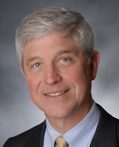Annual Report 2016
Executive Director's Message
A Year of Change

2016 was a period of transition and progress on many fronts for the American Chemical Society (ACS). We continued to innovate, and we introduced several new products. We adopted safety and ethics as core values. We strengthened our global presence. We streamlined our procedures and operations, and that commitment contributed to solid financial progress.
For brevity's sake, I am focusing this message on the most significant changes that occurred in 2016. However, ACS also carried out impressive work on many smaller-scale or continuing projects. Read about those other accomplishments, or learn more details about the changes described below.
Our actions in 2016 were guided by ACS's strategic plan, which outlines the vision, mission and goals for the Society. The strategic plan also lists ACS's core values. At the beginning of the year, just four core values were on the list: passion for chemistry in the broadest sense, focus on members, professionalism, and diversity and inclusion. After studying the matter in 2016, the Society's Board of Directors decided to add both safety and ethics to the list for 2017. This change affirms our commitment to promoting these values through ACS journals, meetings and other products and services among staff, members and the chemistry enterprise as a whole.
Meanwhile, our business units were making their own changes. CAS launched several new products in 2016, including PatentPak™, which helps researchers find important chemistry in patents in half the time; MethodsNow™, which allows analytical scientists to compare methods side by side; and the latest addition to the SciFinder® family, SciFinder-n™, which increases researcher productivity by delivering the most relevant results from CAS content.
ACS Publications unveiled a redesign of Chemical & Engineering News. In addition, the Publications Division launched ACS Sensors; ACS Energy Letters; and ACS Omega, an open-access journal whose four co-editors are based in Canada, China, India and Spain.
ACS Omega is emblematic of our increased emphasis on international outreach. ACS's global presence, in terms of staffing, activities and programming, also continued to grow. And the share of our members who live outside the U.S. rose to 17.5% in 2016 from 15.8% just two years earlier. Why should ACS concern itself with the international sphere? I believe it's the Society's responsibility to connect our members with the practice of chemistry no matter where it takes place.
At the same time, we need to be respectful of other regions' chemical societies and find areas where we can collaborate to our mutual advantage. To this end, we have formed strategic alliances and partnerships with several other societies and organizations outside the U.S. One example is an agreement ACS signed in 2016 with chemical societies from four continents to hold the first Atlantic Basin Conference on Chemistry. ABCChem will take place in Cancún, Mexico, in January 2018.
In another type of alliance — aimed at government relations — ACS teamed up with two other chemistry groups and two Congressmen to launch the bipartisan Congressional Chemistry Caucus in 2016. The caucus informs members of Congress, their staffs and the public about chemistry's benefits for society and the economy.
ACS also reaches the public by sending reporters press releases about scientific advances. In 2016, the Society expanded these efforts with a successful pilot project of embargoed releases, which give reporters advance notice of upcoming ACS journal articles.
Our financial results were strong in 2016. We met four of our five financial goals, and revenue growth was the strongest in a decade, rising 2.9% to a record $526.8 million. We made progress toward reaching our fifth goal, for unrestricted net assets, which represent the Society's financial reserves.
Those results benefitted from several factors. Although we didn't fully end the decline in overall ACS membership last year, we slowed the rate of loss to just 0.5%. Our cost control and revenue growth efforts helped, as did an increase in interest rates and recovery in the financial and equity markets. The numbers also reflect our dedication to streamlining and simplifying ACS operations and eliminating duplication of efforts in 2016.
One example is this annual report, which we have pared back to highlight the most relevant information, while providing interested readers with links to additional details. Other examples include standardization of IT infrastructure and financial systems between the Washington, D.C., headquarters site and the CAS site in Columbus, Ohio, and major revisions by the ACS Board of Directors and Council to governance regulations so the Society can respond more nimbly to the evolving needs of our members.
To remain relevant to the chemical sciences and the chemical enterprise, ACS must embrace change in the Society's structure, processes and offerings, and I believe this overview of our 2016 activities shows progress on that front. I want to thank the ACS Board of Directors and Council, and the ACS staff, for their commitment to this process and their willingness to find better ways to accomplish the Society's objectives.
And most importantly, I'd like to convey my appreciation to our nearly 157,000 members, who inspire us with their dedication to the ACS mission of advancing the chemistry enterprise and its practitioners for the benefit of Earth and its people. On behalf of the ACS staff and Board of Directors, I thank you.
